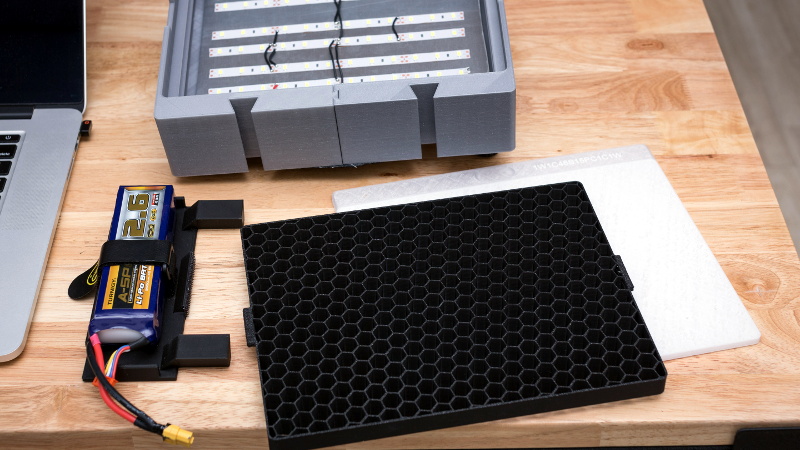Generally speaking, objects made on desktop 3D printers are pretty small. This is of course no surprise, as filament based printers are fairly slow and most don’t have very large beds to begin with. Most people don’t want to wait days for their project to complete, so they use 3D printed parts where it makes sense and supplement them with more traditional components such as aluminum extrusion wherever possible. But not always…
This 3D printed photography softbox created by [Nicholas Sherlock] doesn’t take the easy way out for anything. With the exception of the LEDs and the electronics to drive them, everything in the design has been printed on his Prusa i3. It wasn’t the easiest or fastest way to do it, but it’s hard to argue with the end result. Perhaps even more impressive than the final product is what it took to get there: he actually had to develop a completely new style of part infill he’s calling “Scattered Rectilinear” to pull it off.
 Overall the design of the light itself isn’t that complex, ultimately it’s just a box with some LEDs mounted at the back and a pretty simple circuit to control their intensity. The critics will say he could have just used a cardboard box, or maybe wood if he wanted something a little bit stronger. But the point of this project was never the box itself, or the LEDs inside it. It’s all about the diffuser.
Overall the design of the light itself isn’t that complex, ultimately it’s just a box with some LEDs mounted at the back and a pretty simple circuit to control their intensity. The critics will say he could have just used a cardboard box, or maybe wood if he wanted something a little bit stronger. But the point of this project was never the box itself, or the LEDs inside it. It’s all about the diffuser.
[Nicholas] forked Prusa’s version of Slic3r to add in his “Scattered Rectilinear” infill pattern, which is specifically designed to avoid the standard “ribs” inside of a 3D printed object. This is accomplished with randomized straight infill passes, rather than the traditionally overlapped ones. The inside of the print looks very reminiscent of fiberglass mat, which is perhaps the best way to conceptualize its construction. In terms of the final part strength, this infill is abysmal. But on the plus side, the light from the LEDs passing through it emerges with a soft pleasing look that completely obscures the individual points of light.
Anyone with a big enough 3D printer can run off their own copy of his light, as [Nicholas] has released not only his forked version of Slic3r but all of the STL files for the individual components. He’s also put together an exceptionally well documented Thingiverse page that has instructions and detailed build photos, something that’s unfortunately very rare for that platform.
If you’re in the market for a DIY softbox and don’t have a 3D printer handy, fear not. We’ve covered a few that you can build with more traditional methods, as well as several tips and tricks which you can use to get the most out of your photos and videos.
















What about using a layer or 3 of “White Cambric Bottom Cloth”? the stuff on the bottoms of couches and box-springs?
How would it compare to light light pass-through of the printed mesh?
I’m thinking in terms of color shift or filtering affects that the materials might have on the light source.
The upholstery & mattress fabric can be had for a bit of “sweat equity” ;) and parsing the Craigslist ads.
Always vacuum thoroughly first and
be VERY mindful of those sunny yellow tinted ones! :P
I think it would block more light than the 3D printed one here, depending on materias, of course. Most fabrics are made with opaque white string where as finding translucent 3D printing plastic is trivial. But I’d be very concerned about color shift in either case.
Ready made solutions come quite near in price to a 3D printed one, even more so if you put some value on time spent and especially on optical performance of the finished product. LEE has some awesome diffusion filters sold on roll, you can check http://www.leefilters.com/lighting/diffusion-list.html for selection and comparison. If you prefer ridig diffusion material, I’d check any local plastics/signage shop for “frosted” acrylic sheets. I got some 3mm sheets for my LED panels and was told the acrylic I got was especially designed for diffusing LED light. Not quite sure what that means but I figured it had something to do with the ability to spread/diffuse tiny sources of light as evenly as possible (as with incandescent lights additional diffusion is not as vital as with leds, for example, since the illuminated surface area is larger). With ready made diffusion material you can be certain deep thought has been given to color consistency and maximal possible diffusion.
I am interested in a windows version of Slic3r with the “scattered rectilinear” infill type, but I don’t have experience compiling an executable from the [source code](https://github.com/thenickdude/Slic3r/releases/tag/scattered-rectilinear-1)
Can I get some help? Thanks!
Time to learn someting new I guess : https://github.com/slic3r/Slic3r/wiki/Running-Slic3r-from-git-on-Windows
For the “Cloning the source” part use the repository you linked to.
Huh. That’s a great idea with the infill. See if they’ll include it upstream!
If that infill leaves no closed voids, it would be ideal for resin filling, especially if used with continuous fiber printing.
How is this diffuser better than sanded acrylic?
I have a theory, which is that HaD is actually an insane asylum and we’re all inmates. We accept the bizarre things that other inmates do because, well, we’re no longer rational enough to judge them rationally. In our universe, things like 3D printing stuff that you can buy for pennies and using 555 timers are accepted as perfectly reasonable because we’re all part of the collective delusion.
Prove me wrong.